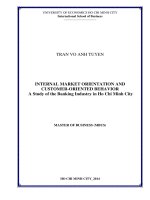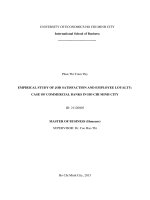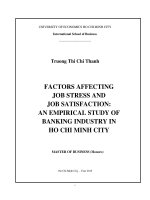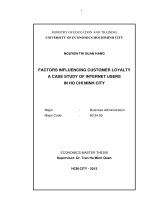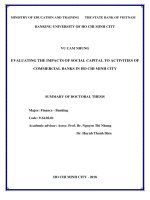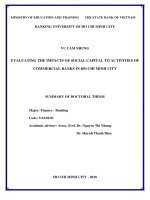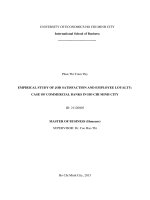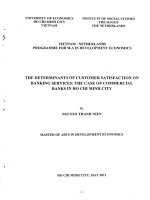Empirical study of job satisfaction and employee loyalty case of commercial banks in ho chi minh city
Bạn đang xem bản rút gọn của tài liệu. Xem và tải ngay bản đầy đủ của tài liệu tại đây (529.18 KB, 84 trang )
UNIVERSITY OF ECONOMICS HO CHI MINH CITY
International School of Business
-----------------------------------
Phan Thi Tram Thy
EMPIRICAL STUDY OF JOB SATISFACTION AND EMPLOYEE LOYALTY:
CASE OF COMMERCIAL BANKS IN HO CHI MINH CITY
ID: 21120005
MASTER OF BUSINESS (Honours)
SUPERVISOR: Dr. Cao Hao Thi
Ho Chi Minh City, 2015
DECLARATION
I hereby declare that this thesis titled “Empirical study of job satisfaction and employee
loyalty: Case of commercial banks in Ho Chi Minh City” is definitely my own work and
effort and it has not been submitted anywhere for any award. Where other sources of
information have been used in this thesis, they have seriously been cited.
Signature: Phan Thi Tram Thy
Date: 28/02/2015
ii
ACKNOWLEDGEMENT
At the beginning of this master’s thesis, I would like to thank all those people who made
this thesis possible and valuable experience for me.
Firstly, I would like to express my sincere gratitude to my supervisor, Dr. Cao Hao Thi, for
his patience, enthusiasm, and immense knowledge to support me in researching and writing
this thesis. Without his guidance, I definitely could not finish my master’s thesis
successfully. He is really a respectful adviser and mentor I have ever had.
Secondly, I would like to express my sincere gratitude to the ISB Research Committee for
their encouragement, insightful comments, and useful support to help students in
researching and writing theses through proposal defense, feedback on first draft, and final
defense.
Thirdly, I would like to thank all the participants who took part in doing the survey in order
that I could collect qualified data for my analysis. I am thankful to my friends who helped
me send the questionnaires to their colleagues and friends in commercial banks to collect
data.
Finally, I would like to express my special thanks to my family for their great love and
continuous support in both spiritually and materially to help me finish my master’s thesis.
iii
Abstract
Employees play an important role in providing services in banking industry and the quality
of services provided for customers is a critical factor of a bank’s performance. Job
satisfaction of employees is directly related to their commitment, performances,
contribution, turnover, and customers’ satisfaction. Thus, this study aims to identify key
determinants of job satisfaction in commercial banks, find out the relationship between job
satisfaction and employee loyalty, make a comparative analysis of job satisfaction and
employee loyalty in different genders and bank sectors such as domestic and foreign banks
in Vietnam, as well as suggest some recommendations for managerial implications. Both
primary and secondary data were used in the study and the sample size of the study was 143
employees from 29 different banks located in Ho Chi Minh City. The study found that
motivation is the most contributing factor to job satisfaction. Other determinants including
payment and benefits, teamwork, nature of work, working conditions, and training and
personal development also had significant influence on job satisfaction of employees.
Moreover, there was a strong positive relationship between job satisfaction and employee
loyalty. In addition, the results indicated that there was no difference in job satisfaction and
employee loyalty between genders and bank sectors.
Key words: Job satisfaction, employee loyalty, motivation, commercial banks, Ho Chi
Minh City.
iv
TABLE OF CONTENT
List of tables, figures, and abbreviations............................................................................. vii
CHAPTER 1: INTRODUCTION .......................................................................................1
1.1. Background of the study ............................................................................................1
1.2. Problem statement .....................................................................................................4
1.3. Research objectives ...................................................................................................5
1.4. Research questions.....................................................................................................5
1.5. Research scope ...........................................................................................................6
1.6. Research structure ......................................................................................................7
CHAPTER 2: LITERATURE REVIEW ...........................................................................8
2.1. Job satisfaction definition ..........................................................................................8
2.2. Factors impact on job satisfaction .............................................................................8
2.2.1. Determinants of job satisfaction ......................................................................9
2.2.2. Demographic variables impact on job satisfaction ........................................10
2.3. Studies about job satisfaction in general and in banking industry ..........................11
2.4. Employee loyalty definition ....................................................................................12
2.5. Relationship between job satisfaction and employee loyalty ..................................13
2.6. Hypotheses and research model...............................................................................13
2.6.1. Participations and empowerment ...................................................................13
2.6.2. Working conditions .......................................................................................14
2.6.3. Rewards and recognition ...............................................................................14
2.6.4. Teamwork ......................................................................................................15
2.6.5. Training and personal development...............................................................15
2.6.6. Payment and benefits .....................................................................................16
2.6.7. Nature of work ...............................................................................................16
2.6.8. Impact of job satisfaction on employee loyalty .............................................17
2.6.9. Impact of gender on job satisfaction and employee loyalty ..........................17
2.6.10. Impact of bank sector on job satisfaction and employee loyalty .................18
CHAPTER 3: RESEARCH METHODOLOLY .............................................................21
3.1. Research process .....................................................................................................21
3.2. Data collection methods ..........................................................................................22
3.3. Data analysis methods .............................................................................................23
3.4. Measurement of constructs......................................................................................24
CHAPTER 4: DATA ANLYSIS .......................................................................................28
4.1. Sample description...................................................................................................28
4.2. Reliability test for 9 constructs ................................................................................29
4.2.1. Participations and empowerment ...................................................................29
4.2.2. Working conditions .......................................................................................31
4.2.3. Rewards and recognition ...............................................................................31
4.2.4. Teamwork ......................................................................................................31
4.2.5. Training and personal development...............................................................32
4.2.6. Payment and benefits .....................................................................................32
4.2.7. Nature of work ...............................................................................................32
v
4.2.8. Job satisfaction ...............................................................................................32
4.2.9. Employee loyalty ...........................................................................................33
4.3. Exploratory factor analysis ......................................................................................33
4.3.1. EFA for independent constructs ....................................................................33
4.3.2. EFA for dependent constructs .......................................................................36
4.3.2.1. EFA for dependent construct of job satisfaction ........................................36
4.3.2.2. EFA for dependent construct of employee loyalty .....................................37
4.4. Linear regression .....................................................................................................40
4.4.1. Regression model 1........................................................................................40
4.4.2. Regression model 2........................................................................................42
4.5. Analysis of variance (ANOVA test) ........................................................................42
4.5.1. Impact of gender on job satisfaction ..............................................................43
4.5.2. Impact of gender on employee loyalty ..........................................................43
4.5.3. Impact of bank sector on job satisfaction ......................................................44
4.5.4. Impact of bank sector on employee loyalty ...................................................44
4.6. Discussion for data analysis results .........................................................................45
CHAPTER 5: CONCLUSIONS ........................................................................................50
5.1. Research findings ....................................................................................................50
5.2. Managerial implications ..........................................................................................50
5.3. Limitation and further researches ............................................................................53
REFERENCES ...................................................................................................................54
APPENDIX .........................................................................................................................66
Appendix 1 .....................................................................................................................66
Appendix 2 .....................................................................................................................68
Appendix 3 .....................................................................................................................71
Appendix 4 .....................................................................................................................74
Appendix 5 .....................................................................................................................77
vi
LIST OF TABLES
Table 2.1: Studies of factors influence job satisfaction in banking industry .......................15
Table 3.1: Measurement scale of constructs in the study.....................................................31
Table 4.1: Descriptive statistics of the study sample ...........................................................34
Table 4.2: Cronbach’s Alpha reliability test results .............................................................34
Table 4.3: Cronbach’s Alpha reliability test results of deleted items ..................................35
Table 4.4: KMO and Bartlett's Test for independent constructs ..........................................38
Table 4.5: Factor analysis result of determinants of job satisfaction ...................................39
Table 4.6: Total variance explained by 6 determinants of job satisfaction..........................40
Table 4.7: KMO and Bartlett's test for dependent construct of job satisfaction ..................41
Table 4.8: Factor analysis result of dependent construct of job satisfaction .......................41
Table 4.9: Total variance explained by dependent construct of job satisfaction .................41
Table 4.10: KMO and Bartlett's test for dependent construct of employee loyalty .............42
Table 4.11: Factor analysis result of dependent construct of employee loyalty ..................42
Table 4.12: Total variance explained by dependent construct of employee loyalty ............41
Table 4.13: Regression analysis result of model 1 ...............................................................44
Table 4.14: Regression analysis result of model 2 ...............................................................45
Table 4.15: Descriptive statistics of gender .........................................................................46
Table 4.16: ANOVA analysis – Impact of gender on job satisfaction ................................46
Table 4.17: ANOVA analysis – Impact of gender on employee loyalty .............................47
Table 4.18: Descriptive statistics of bank sector ..................................................................47
Table 4.19: ANOVA analysis – Impact of bank sector on job satisfaction .........................48
Table 4.20: ANOVA analysis – Impact of bank sector on employee loyalty ......................48
Table 4.21: Testing results of 11 hypotheses in the research model ....................................48
LIST OF FIGURES
Figure 2.1: Theoretical framework.......................................................................................23
Figure 3.1: Research process of the study ............................................................................25
Figure 4.1: Revised research model .....................................................................................43
LIST OF ABBREVIATIONS
ANOVA: Analysis Of Variance
EFA
: Exploratory Factor Analysis
KMO : Kaiser – Meyer – Olkin statistics
vii
CHAPTER 1: INTRODUCTION
This chapter presents an overview of the study, including background of the study, problem
statement, research objectives, research questions, and research scope. Structures of the
study is also presented in this chapter.
1.1.
Background of the study
Human resources play an important role in establishment and development of organizations.
Fletcher and Williams (1996), Al-Aameri (2000), and Fang (2001) indicate that employees
satisfy with their jobs tend to have more loyalty towards the organizations, and contribute
more than those who dissatisfy. Thus, satisfied employees can help to increase retention and
decrease turnover rate as well as save recruiting and training costs. Understanding that
human resource is a valuable capital of an organization, there are many studies about job
satisfaction all over the world. Among them, there are two famous studies from that others
are based on. They are study of Locke in 1976 and study of Herzberg, Mausner, and
Snyderman in 1959.
Locke (1976) defines job satisfaction as a pleasurable or positive emotional state resulting
from the appraisal of one’s job or job experiences. He also points out nine dimensions of
job, including nature of work, pay, promotion, recognition, benefits, working conditions, coworkers, and company and management. In his causal models of job satisfaction, Locke
finds strong positive relationships among these job dimensions with job satisfaction.
Another famous study of job satisfaction is Herzberg’s motivator – hygiene theory in 1959.
Herzberg et al. (1959) classify incidents involving the work itself, achievements, promotion,
recognition, and responsibility are frequently mentioned as sources of satisfaction. This
group of factors is labeled Motivators. While incidents classified as involving supervision,
interpersonal relations, working conditions, company policies, and salary are frequently
mentioned as causes of job dissatisfaction. This group of categories is labeled Hygienes.
The two-factor theory of job satisfaction parallels the theory of man’s needs based on
Maslow theory, in which the Hygiene factors operate to fulfill man’s physical needs, while
the Motivators serve to fulfill man’s psychological needs.
1
Based on these studies, job satisfaction is researched in many different countries and all the
researches get the results that prove the relationships among these factors and job
satisfaction. Lim (2008) examining the job satisfaction of library information technology
workers in the United States finds that salary, a sense of belonging, job autonomy, and
promotion opportunities are related to job satisfaction. The conclusion drawn from the study
of Sesil (1999) in High Technology Establishments of United Kingdom is that there is a
strong and positive impact on job satisfaction associated with the use of employee
involvement and group incentives. Another study about job satisfaction compared between
Canada and India shows that employees who exhibit job satisfaction and work experience
behaviors are more likely to heighten their desires to be empowered, regardless of cultural
context (Gill, Sharma, Mathur, & Bhutani, 2012).
Besides American and Europe, Asia, Africa, and Middle East also have many studies about
job satisfaction. Koh, Ma, and Kuek (2012) studying about the relationships among job
satisfaction, job performance, and job stress in the context of higher learning institutions in
Malaysia find that job stress has negative impact on job satisfaction and then, job
satisfaction affects job performance in a positive relationship. According to Ashok and Lekh
(2013), pay, promotion, work itself, supervision, and co-workers can contribute to increase
the job satisfaction of managers in pharmaceutical industry in Himachal Pradesh of India.
Sadegh and Azadeh (2012) also indicate supervision, relationship with co-workers, nature of
work, opportunities for promotion, and present pay all have important influence job
satisfaction when they do an empirical study at airline industry in Iran.
In Nigeria, Oyebamiji, Kareem, and Ayeni (2013) show that job satisfaction dimensions
including pay, supervision, promotion, work itself, and work conditions have significant
effect on job performance, which account for 33% variance of job performances. The study
conclude that small and medium enterprises managers should use these job satisfaction
dimensions as policy instruments for retention to reduce employee turnover and enhance job
performance.
2
Studies about job satisfaction are not only popular in many countries but also diversify in
different fields and research objectives. Job satisfaction are researched in technology (Sesil,
1999; Lim, 2008), banking industry (Islam, Mohajan & Datta, 2012; Mansor, Noor &
Hassan, 2012; Muhammad and Kamal, 2009), governments (Krzysztof & Bartomicj, 2013;
Turkyilmaz, Akman, Ozkan, & Pastuszak 2011), hotel industry (Hussain, 2012; Abdullah,
Musa, Zahari, Rahman, & Khalid 2011), textile industry (Ami, Shiji, & Shamira, 2012),
health care (Harmon et al., 2003), pharmaceutical industry (Ashok & Lekh, 2013), and
many other industries.
Objectives of studies about job satisfaction vary according to authors’ purposes. There are
researches on determinants of job satisfaction, for instant Kumar and Singh (2011)
investigate job satisfaction and its correlates, Seashore and Tabler (1975) research about job
satisfaction indicators and their correlates. There are many studies compare the differences
in job satisfaction between genders and bank sectors, such as Sadegh and Azadeh (2012) do
an evaluation of employees’ job satisfaction and role of gender difference at airline industry
in Iran, or comparative study about job satisfaction of public sector and private sector banks
of Devi and Suneja (2013).
Other authors research about the demographic attributes and job satisfaction, such as
Santosh and Santoshi (2014). Some authors investigate the relationship between some of job
dimensions and job satisfaction, for instant study about the impact of employee participation
on job satisfaction, employee commitment, and employee productivity (Komal and Tahir,
2007), impact of salary differential on managerial job satisfaction (Okpara, 2004),
relationship between job satisfaction and job commitment (Luqman, Bolaji, & Abubakar,
2012), job satisfaction and job performance relationship (Timothy, Carl, Joyce, & Gregory,
2001), work values and job satisfaction (Ju, Mohd, Datin, & Kong, 2006), etc.
In banking industry, low level of job satisfaction makes difficulties in increasing service
quality, including long working hours, workload pressure, unfairness in promotion and
salary, and uncomfortable working environment, etc. Job satisfaction directly relates to
employees’ performance, absenteeism, commitment, turnover, and citizenship behaviors
3
that has a direct influence on the bank's performance (Koh and Boo, 2001). Moreover,
empirical study shows that job satisfaction of employee has a direct influence on customers'
satisfaction (Yee, Yeung, & Cheng, 2008). Therefore, studying job satisfaction plays an
important role in improving employee performance, increasing the bank performance, and
customer satisfaction. In Vietnam, there are some studies about job satisfaction of
employees in banking industry, for instant Nguyen (2012) studies about job satisfaction of
Eximbank in Da Nang province, Phan (2011) analyzes factors influence job satisfaction of
commercial banks in Thua-Thien Hue province, and Mai and Bui (2013) identify factor
influencing employee loyalty directly and indirectly through job satisfaction in banking
sector in Ho Chi Minh City.
Based on those researches, this study focuses on investigating determinants of job
satisfaction in commercial banks in Ho Chi Minh City in Vietnam to find out the impact of
these factors on job satisfaction. In addition, relationship between job satisfaction and
employee loyalty as well as the difference in job satisfaction and employee loyalty between
genders and bank sectors are also investigated in this study.
1.2.
Problem statement
In the period of the economic crisis from 2008 to 2014, there have been many internal
management problems in banking industry in Vietnam. One of these problems is a lot of
change in human resources of commercial banks. According to Minh (2014), many
commercial banks have fired hundreds of employees to cut cost in recent years, for instant,
Maritime Bank fired more than 1,300 employees and Asia Commercial Bank reduced 1,100
employees during 2013, Saigon – Hanoi Bank reduced 660 employees within the first 6
months of 2014. This reduction leads to a problem that remained employees have more
workload and become more stressful. Moreover, high and middle level managers are still
important to the development of the banks, especially in this crisis period (Quoc, 2013).
Therefore, skillful employees and managers are valuable assets to the banks. In addition, job
responsibilities in commercial banks in Vietnam do not have a lot of difference, thus
employees can easily move from one bank to another one that have more attractive benefits.
4
That is the reason why banks need to have strategies to remain their brilliant employees by
increasing their job satisfaction and their loyalty towards organizations.
However, there are few studies about job satisfaction in banking industry in Vietnam at this
time, including Nguyen (2012), Phan (2011), and Mai and Bui (2013). In Ho Chi Minh City,
there is only study of Mai and Bui (2013) finding out determinants of job satisfaction,
including supervisor support, fringe benefits, teamwork, working environment, and training.
Thus, besides those determinants, this study aims to find out more factors affect job
satisfaction in commercial banks in Ho Chi Minh City to contribute to the understanding of
employee demands and requirements in order to increase management efficiency, increase
employee loyalty, and achieve a higher customer satisfaction.
1.3.
Research objectives
The study aims to identify factors influence job satisfaction of employees working for
commercial banks in Ho Chi Minh City as well as the level impact of these factors on job
satisfaction. In addition, the study identifies the impact of job satisfaction on employee
loyalty and finds out if there is difference in job satisfaction and employee loyalty between
genders and bank sectors.
1.4.
Research questions
To achieve the research objectives, the study will find the answers for these following
questions:
-
What are factors that influence job satisfaction in commercial banks in Ho Chi Minh
City?
-
What are the impact level of these factors on job satisfaction of employees in
commercial banks in Ho Chi Minh City?
-
What is the influence of job satisfaction on employee loyalty in commercial banks in
Ho Chi Minh City?
-
Is there any difference in job satisfaction and employee loyalty between genders and
bank sectors?
5
1.5.
Research scope
The limitation of location in this study is in Ho Chi Minh City that is the most populous city
and the second largest one in Vietnam. This city is also center of economics, culture, and
education of the country. In the first 6 months of 2014, Ho Chi Minh City contributes
22.71% to GDP of the whole country in which services accounts for 59.38% of GDP of the
city (Statistical Office in Ho Chi Minh City, 2014).
There are 378 branches of 61 banks operating in Ho Chi Minh City including 4 bank sectors
classified based on the bank’s ownership structures at the end of 2013 (Thuy, 2013) . The
first bank sector is 3 banks of Vietnamese government, including Vietnam Bank for Social
Policies, Vietnam Development Bank, and State Bank of Vietnam. The second bank sector
is 13 foreign commercial banks that have 100% of capital from foreign countries, including
Australia And Newzealand Bank, Deutsche Bank, Citibank, HSBC, Standard Chartered
Bank, Shinhan Bank, Hong Leong Bank, Mizuho, Credit Agricole, Tokyo-Mitsubishi,
Sumitomo Mitsui Bank, Commonwealth Bank, and Bank of Investment and Development
Cambodia. The third bank sector is 5 joint-venture commercial banks, including Indovina
Bank, Vietnam - Russia Bank, VID Public Bank, Vinasiam Bank, and Lao – Viet Bank. The
rest are 40 domestic commercial banks, including Sacombank, Asia Commercial Bank,
Techcombank, Eximbank, etc. The Vietnamese government banks account for nearly 5% of
banking industry in Ho Chi Minh City, while commercial banks account for more than 95%;
thus this study focus on commercial banks in Ho Chi Minh City for data collection.
Therefore, the limitation of location in this study is employees working for commercial
banks in Ho Chi Minh City, such as Vietcombank, Vietinbank, Eximbank, Agribank,
Military Bank, Asia Commercial Bank (ACB), Western Bank, Sacombank, HSBC, ANZ,
Standard Chartered, etc.
The data will be collected through questionnaires in September 2014 with the respondents
are banking employees and the research objects are job satisfaction and employee loyalty.
6
1.6.
Research structure
This study includes 5 chapters. Chapter 1, introduction, presents the necessity of the study
including background of the study, problem statement, research objectives as well as the
research scope and an overview of the study structure. Chapter 2, literature review, presents
previous studies about job satisfaction and employee loyalty. It includes studies in many
industries in different countries and focus on studies in banking industry. Based on the
literature review, hypotheses and research model will be suggested for this study. Chapter 3,
research methodology, includes process of the study, data collection methods, data analysis
methods, and measurement of constructs in the study. Chapter 4, data analysis, shows and
discusses research results, including the results of descriptive statistics, reliability tests for
measurement scales, exploratory factor analysis of variables, regression of independents
and dependent variables, and analysis of variances for job satisfaction and employee loyalty
based on gender and bank sector. Chapter 5, conclusions, summaries findings of the study
and recommends some managerial implications. The limitation of this study and suggestions
for further research in the future will be discussed in this chapter.
7
CHAPTER 2: LITERATURE REVIEW
This chapter presents the literature review studies about job satisfaction in the world
including definitions, determinants of job satisfaction, and statistics of research papers about
this field. Based on the result of literature review, hypotheses and research model are built
to test the relationships among determinants and job satisfaction as well as the relationship
between job satisfaction and employee loyalty in commercial banks in Ho Chi Minh City.
2.1.
Job satisfaction definition
There are plenty of researches investigating on job satisfaction, such as Kuo and Chen
(2004), Ellickson (2002), Groot and Brink (1999), and Rogers, Clow, and Kash (1994). The
definition of job satisfaction is frequently based on Maslow's need hierarchy theory,
Herzberg's motivator-hygiene theory, Vroom’s expectancy theory, and Adam's fairness
theory.
According to Locke (1976), job satisfaction is a pleasure or positive emotional state
resulting from the perception by the individual of his or her job as implementing or giving
the opportunity to realize significant values available in the work, if these values are
consistent with his or her needs.
Robbins (2003) defines job satisfaction as an individual's general attitude towards his or her
job. Price (1997) defines job satisfaction as the degree to which employees have a positive
affective orientation towards employment by the organization. In general, job satisfaction is
the degree to which people enjoy in doing their job.
2.2.
Factors impact on job satisfaction
There are many factors impact on job satisfaction of employees classified into 2 groups. The
first group is determinants of job satisfaction, which are the causes of job satisfaction,
include employee participation, hygiene factors, fair and empathic management, working
environment, job characteristics, and job promotion. The second group is demographic
variables that have relationship with job satisfaction, including gender, marital status,
education, income, and age.
8
2.2.1. Determinants of job satisfaction
Employee participation: Wagner (1994) and Linda (1998) indicate that employee
participation has a positive impact on their performance. The more employees participate
and involve in decision-making process, the higher commitment they have towards their
organization. Vander, Blonk, Schene, & Van (2001) shows that interdependence in-group
task could increase degree of job satisfaction because it increases the feeling of
belongingness and coordination among employees.
Hygiene factors: According to Zohir (2007), non-financial benefits such as canteen
facilities, transport facilities, and other company policies have impact on employees’ quality
of life, thus hygiene factors can increase employees’ satisfaction and their performance.
Moreover, Rahman (2005) and Yussuf (2008) identify technological innovation in working
can bring higher level of service quality as well as volume productions.
Fair and empathic management: Locke (1976) indicates that equal reward and
recognition have important effect on job satisfaction. In addition, Foel, Driskell, Mullen,
and Salas (2000) prove that employees experience democratic leadership tend to be more
satisfied than those who experience autocratic leadership; thus, style leadership can
influence job satisfaction.
Working environment: According to Locke (1976) and Bajpai and Srivastava (2004),
good working environment with friendly and coordinative colleagues can increase job
satisfaction. Dunham-Taylor (2000) also argues that organization investment in employees
such as motivating to learn and regular training can result in higher satisfaction of
employees.
Job characteristics: Locke (1976) indicates that work of itself including intrinsic interest,
variety, opportunity for learning, difficulty, amount, chances for success, control over pace
and methods, etc. Employees tend to be more satisfied with jobs can provide them
opportunities to master their skills and competences with a variety of tasks, freedom, and
feedback. They seem to feel boring with jobs that do not have a lot of challenge or feel
failed with too much challenged jobs.
9
Job promotion: Fair promotion policies in the organization become the foundation of
growth. Kalleberg and Mastekaasa (2001) find that promotion increase employees
perception of their job quality as well as their satisfaction and commitment. Witt and Nye
(1992) also indicate the similar study result.
2.2.2. Demographic variables impact on job satisfaction
Gender: There are many arguments in studying relationship between gender and job
satisfaction. Clark (1997), Sloane and Williams (1996), and Ward and Sloane (1998) claim
that women tend to be more satisfied at work than men; while other researchers such as
Forgionne and Peeters (1982), Shapiro and Stem (1975) find that men to be more satisfied
than women.
Marital status: There are some arguments in studying the relationship between marital
status and job satisfaction. Fetsch and Kennington (1997) find that divorced and married
employees tend to be more satisfied with their jobs than single employees are, while Scott,
Swortzel, and Taylor (2005) find no relationship between marital status and job satisfaction.
Education: Churchill, Ford, and Walker (1979) indicate that level of education has a
positive impact on job satisfaction because an individual expectation increases when level
of education increases. Bilgic (1998) also finds that employees with higher level of
education pay more attention to productivity and have fewer negative feeling with their jobs
than others have. In addition, Bajpai and Srivastava (2004) indicate that if employees feel
their qualification cannot match the jobs, they would be dissatisfied. Al-Ajmi (2001),
Falcone (1991), and Okpara (1996) also find the positive relationship between education
level and job satisfaction.
Income: According to Bilgic (1998), Sokoya (2000), Sweeney, McFrarin, and Inderrieden
(1990), Howard and Frink (1996), there is a significant difference in job satisfaction levels
of employees based on their income. Employees with low income tend to report lower level
of job satisfaction than others do. Highly paid employees may still be dissatisfied if they do
not like the nature of their jobs (Luddy, 2005).
10
Age: Many research papers show a positive relationship between job satisfaction and age,
including Rhodes (1983), Lee and Wilbur (1985), Weaver (1978); while others find a
negative or insignificant correlation between age and job satisfaction (Herzberg, Mausner,
Peterson, & Capwell, 1957; Singh and Singh, 1980).
2.3.
Studies about job satisfaction in general and in banking industry
There are many studies about job satisfaction of employees in different countries in the
world confirm the literature review. These studies are shown in Appendix 1. Job satisfaction
is not only studied in many different countries but also in many different industries, such as
engineering, public services, and hotel industry, etc. There are many studies investigating
determinants of job satisfaction in banking industry as well. Table 2.1 presents the summary
of these studies.
Table 2.1: Studies of factors influence job satisfaction in banking industry
Title of study
Determinants of job satisfaction in
banking industry
Authors (Year)
Factors influencing job
satisfaction of banking sector
employees in Chennai, India
Pay and promotion, organization aspects,
supervisor behavior, job and working
condition, and coworker behaviors
Sowmya and
Panchanatham (2011)
Job satisfaction among bank
employees in Punjab,
Pakistan: A comparative
study
Pay and job security
Khalid and Irshad (2010)
Job satisfaction in
commercial banks of
Bangladesh with different
ownership structures: A
comparative study
- Job relating factors: job security, fair job
design, challenging work, status, authority
and responsibility, autonomy, personal
growth, balance between life and work,
opportunities to use skills, quality of
supervision.
Mohammed (2006)
- Benefits: Salary, medical facilities,
training and development, housing and
others.
- Relationship: Relationship with
supervisor, teamwork, relationship with
coworkers.
- Working environment: Working
conditions, safety and security, culture of
the bank, rules and regulations, availability
11
of resources, working hours, and working
conditions.
- Management behaviors: Fairness in
promotions, fairness in performance
evaluation, timely feedback on
performance, recognition of performance,
commitment to professional development,
concerns towards employees' well-being,
freedom to express opinions,
communication.
Demographic attributes and
job satisfaction in banks in
India
Participate environment, hygiene factors,
fair and empathic management, service
quality, accessibility, age, and education.
Santosh and Santoshi
(2014)
A study on job satisfaction
and morale of commercial
banks in Bangladesh
- Personal factors: gender, age, time on job,
religion
Islam et al. (2012)
- Factors inherent in the job: type of work,
skill required, occupation status,
commitment to organization, size of
organization, place of work
- Factors controllable by management:
security, pay, opportunity for
advancement/promotional opportunity,
working conditions, supervision.
Analysis of the factors
influencing job satisfaction of
the commercial banks’ staff
in ThuaThien-Hue province
Salary, bonus policies, incentive
mechanisms, work pressure, leadership,
training, promotion, work behavior, and
relationship.
Phan (2011)
Study of job satisfaction of
staff in Eximbank – Da Nang
branch
Compensation, leadership, training,
promotion, work itself, co-workers, and
working conditions.
Nguyen (2012)
2.4.
Employee loyalty definition
According to Allen and Grisaffe (2001), loyalty is a psychological state and it characterizes
the relationship of an employee with the organization they work for and that has
implications for their decision to remain with the organization. According to Becker and
Billings (1993), loyalty could be defined as a strong desire to maintain a member of an
organization; a willingness to slug on high levels of efforts for the sake of the organization;
and a definite belief in and admissibility of the values and goals of the organization.
12
2.5.
Relationship between job satisfaction and employee loyalty
There are many studies about the relationship between job satisfaction and employee loyalty
in different industries and countries. Turkyilmaz, Akman, Ozkan, and Pastuszak (2011)
indicate that there is a strong positive impact of job satisfaction on employee loyalty in
public sectors in Turkey, in which job satisfaction can explain almost 50% variance of
employee loyalty. Abdullah et al. (2009) investigating the linkage of job satisfaction and
employee loyalty in hotel industry in Malaysia find out that employee loyalty is a result of
job satisfaction that stems from determinants of satisfaction, such as recognition and
rewards, working conditions, teamwork and cooperation, and relationship with supervisors.
These four determinants of job satisfaction correlate with all three aspect of employee
loyalty in this study, namely, employment tenure, planning career with company, and
recommending employment. Hussain (2012) also finds out a linkage of job satisfaction and
employee loyalty in hotel industries of Pakistan through the strong correlation between
employee loyalty variables with variables of job satisfaction, including relation with boss,
performance appraisal, situation and place of work, group work, and coordination. In
banking industry in Vietnam, Mai and Bui (2013) indicate that the higher levels of job
satisfaction, supervisor support, fringe benefits, teamwork, working environment, and
training are positively associated with the higher level of employee loyalty.
2.6.
Hypotheses and research model
Based on the literature review, there are many factors influence on job satisfaction. In this
study, providing factors of job satisfaction are determined based on characteristics of the
commercial banks in Ho Chi Minh City surveyed in this study and the literature review.
They are participation and empowerment, working conditions, reward and recognition,
teamwork, payment and benefits, nature of work, and training and personal development.
2.6.1. Participation and empowerment
Participation consists of involvement of employees in management and decision making
related to strategies, goals, and policies of the companies. Chao et al. (1994) indicate that
13
employees' understanding of goals, values, and politics of their companies are positively and
significantly related to job satisfaction.
Empowerment involves creating values for employees to do their job independently without
constant intervention of management to develop individual and organizational performance
and help employees achieve their goals. According to Snipes, Oswald, Tourc, and
Armenakis (2005), employees' feeling of empowerment has a positive impact on job
satisfaction.
Based on the influence of participation and empowerment on job satisfaction, Hypothesis 1
(H1) is proposed as following.
H1: There is a positive relationship between participation and empowerment and job
satisfaction.
2.6.2. Working conditions
According to Locke (1976), physical working condition consists of comfortable workplace,
temperature, humidity, ventilation, lighting, and noise. The moderate degrees of these
features are preferred to extreme degrees since too little light or too much heat can cause
physical discomfort and reduce employee’s ability to work. Barnowe, Mangione, and Quinn
(1972) also find that most employees value a location close to home, new buildings,
cleanliness, and adequate tools and equipment. Job satisfaction increases when the company
provides more physically comfortable working conditions. According to De Troyer (2000),
low job satisfaction levels can be mainly imputed to the physical working conditions. Based
on the relationship between working conditions and job satisfaction, Hypothesis 2 (H2) is
proposed as following.
H2: There is a positive relationship between working conditions and job satisfaction.
2.6.3. Rewards and recognition
Maurer (2001) suggests that rewards and recognition should be linked to organizational
success as a result of employee job satisfaction and they are frequently considered as one of
14
the key factors influencing job satisfaction. The lack of proper reward and recognition
decreases job satisfaction of employees.
Locke (1976) also finds that recognition is one of the most mentioned factors causing job
satisfaction and dissatisfaction, especially among blue-collar workers. Moreover,
recognition provides feedback concerning the competences of employee performances in
order that they can correct past errors and set future goals for performance to become more
efficacious. Promotion considered as a type of rewards and recognition also affect job
satisfaction because it satisfies the desire for psychological growth, justice, higher earnings,
and social status as indicated in Locke (1976). Based on the impact of rewards and
recognition on job satisfaction, Hypothesis 3 (H3) is proposed.
H3: There is a positive relationship between rewards and recognition and job satisfaction.
2.6.4. Teamwork
Effective teamwork can motivate employees and improve employee performance and selfefficacy. This increases motivation and self-efficacy through teamwork can be a source of
employee autonomy, significance, bonding with team members and satisfaction (Griffin,
Patterson, and West, 2011). Volkwein, Malik, and Napierski (1998) also find that teamwork
has a positive relationship with job satisfaction and work stress caused by interpersonal
relationships is negatively associated with job satisfaction. According to research result of
Volkwein and Zhou (2003), teamwork and interpersonal relationships are more influential
on job satisfaction than organizational, environmental, and personal characteristics. Based
on the relationship between teamwork and job satisfaction, Hypothesis 4 (H4) is proposed
as following.
H4: There is a positive relationship between teamwork and job satisfaction.
2.6.5. Training and personal development
Employee training provides opportunities to employees widen their knowledge and abilities
for more efficient teamwork and achieve individual development (Jun, Cai, & Shin, 2006).
When workers receive self-development training, the level of their job satisfaction is higher
15
than those without training (Saks, 1996). In addition, Martensen and Gronholdt (2001) find
out that the development of individual competencies through various training programs has
a positive influence on job satisfaction. When employees attend to training programs, they
gain self-confidence of making their jobs, they perceive career development opportunities
and they think that their companies make investment in them (Jun et al., 2006). As result of
this positive situations, job satisfaction increases. Based on the impact of training and
personal development on job satisfaction, Hypothesis 5 (H5) is proposed as following.
H5: There is a positive relationship between training and personal development and job
satisfaction.
2.6.6. Payment and benefits
According to Locke (1976), payment includes amount, fairness or equity, method of
payment, etc., whereas pension, medical, annual leave, paid vacations, etc. are included in
benefits. Lai (2011) argues that an efficient compensation system result in organizational
growth and expansion and exhibit a positive relationship between job satisfaction and
job-based wages, skill-based pay, and performance-based pay. The study concludes that
the intrinsic factors of motivation, including recognition, work, career opportunities,
professional growth, responsibility, good feeling about the organization that has a
significant correlation with job satisfaction. Based on the influence of payment and benefits
on job satisfaction, Hypothesis 6 (H6) is proposed as following.
H6: There is a positive relationship between payment and benefits and job satisfaction.
2.6.7. Nature of work
According to Locke (1976), nature of work includes new learning, creativity, autonomy,
coping with difficulties, and being responsible for decisions all involve the use of
employee’s conceptual faculty that is called mental challenge. In the absence of an adequate
mental challenge, employee experiences boredom that is the result of unused mental
capacity. If the challenge of the work is sufficiently great and is accepted by the employee,
he or she should become both interested and involved in the job (Ford, 1969; Patchen,
1970). Herzberge et al. (1959) and Strong (1943) also indicate that an important
16
precondition of work satisfaction is that the individual finds the work itself personally
interesting and meaningful.
In addition, Hansia (2009) concludes that the majority of people or employees agree that
personality type suits the work they do, and have the opportunity to do what they do best
and they are optimistic about their personal and professional life. Hansia (2009)
demonstrates that the procedures for recruitment and selection are an important predictor of
job satisfaction of employees, and fair policy of recruitment and selection leads to job
satisfaction at work.
Based on the relationship between nature of work and job satisfaction, Hypothesis 7 (H7) is
proposed as following.
H7: There is a positive relationship between nature of work and job satisfaction.
2.6.8. Impact of job satisfaction on employee loyalty
Empirical evidences suggest that employee job satisfaction has a positive impact on
employee loyalty, such as Fletcher and Williams (1996), Al-Aameri (2000), and Fang
(2001). In contradiction, low job satisfaction could cause employees to recede from their
jobs or change their current jobs and careers. Soler (1998) indicates that low job satisfaction
leads to low loyalty to organization, low employee morale, and increases job turnover.
Based on the relationship between job satisfaction and employee loyalty, Hypothesis 8 (H8)
is proposed as following.
H8: There is a positive relationship between job satisfaction and employee loyalty.
2.6.9. Impact of gender on job satisfaction and employee loyalty
As one of the most important demographic variables, the relationship between gender and
job satisfaction is tested in many studies; however, the results are inconsistent. Many studies
find that there is a significant relationship between gender and job satisfaction, in which
Sloan and Williams (1996), Clark (1997), and Kim (2005) indicate that women are more
satisfied with their jobs than men; while Sharpio and Stern (1975) and Weaver (1974) find
that men are more satisfied with their job than women. Conversely, other studies show that
17
there is no significant relationship between genders of employees and their job satisfaction,
such as Hossain (2014), Kuo and Chen (2004), and Oshagbemi (2000).
Due to the contradictory in research results of relationships between genders and job
satisfaction, Hypothesis 9a (H9a) is proposed as following.
H9a: There is difference in job satisfaction between genders.
Based on the strong positive relationship between job satisfaction and employee loyalty as
predicted in Hypothesis 8, this study examines the impact of gender on employee loyalty as
presented in Hypothesis 9b (H9b).
H9b: There is difference in employee loyalty between genders.
2.6.10. Impact of bank sector on job satisfaction and employee loyalty
There are similar contradiction in research results about relationship between bank sectors
and job satisfaction. Sahgal (2012) finds that there is not much difference in the level of job
satisfaction between public banks and private banks; however, regarding some factors like
job security, salary, and benefits given to employees, the job satisfaction level differs in
both bank sectors. Islam and Saha (2001) indicate that private bank officers have higher
levels of job satisfaction than those from public sector as they enjoy better facilities and
supportive work environment. Devi and Sunja (2013) also find out significant difference
exists between employees of public and private banks regarding various aspects of job
satisfaction. According to Mohammed (2006), public banks lead in terms of job security,
autonomy, balance between work and life, authority and responsibility, whereas foreign
banks lead in terms of salary, status, and timely feedback.
Due to the contradictory in research results of relationships between bank sectors and job
satisfaction, Hypothesis 10a (H10a) is proposed as following.
H10a: There is difference in job satisfaction between bank sectors.
Based on the strong positive relationship between job satisfaction and employee loyalty as
predicted in Hypothesis 8, this study examines the impact of bank sector on employee
loyalty as presented in Hypothesis 10b (H10b).
18

